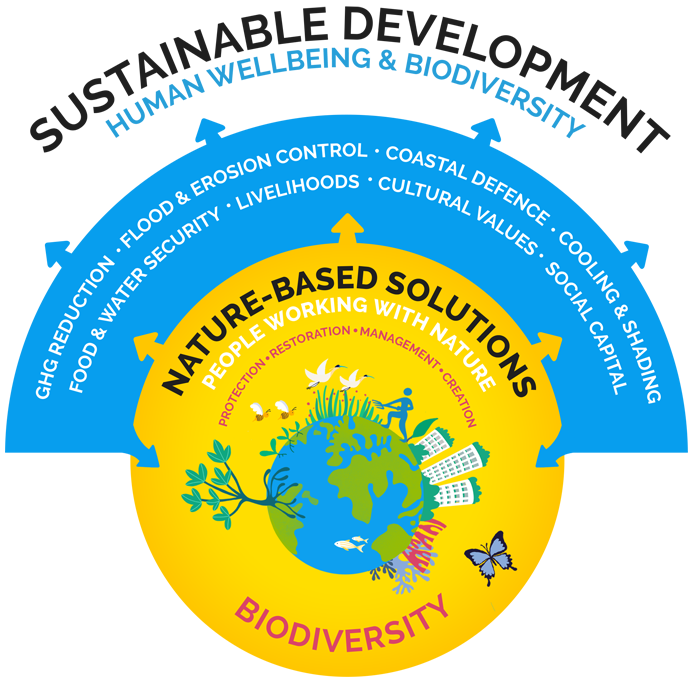Researched and Written by Maddie Williamson, Student at the University at Exeter
For a long time, humans and animals have relied on nature to help combat the climate-based problems they have faced around the globe. Recently, however, we have begun to look at nature in a new way, to help figure out better solutions for the climate change crisis. In her talk, Audrey Wagner, the programme co-ordinator for the Nature-based Solutions Initiative, discussed how NbS can offer some new approaches to get better and faster results in mitigating and adapting to climate change.
Although NbS can help us mitigate global warming, one of the main issues is overestimation of their effects and capability. Audrey used the example of Greenhouse gas (GHG) to demonstrate this. For example, 22% of our annual GHG emissions come from the AFOLU sector and NbS can help to reduce this number. They can also go even beyond this reduction and possible help to remove the need for GHGs. Unfortunately, there have been a lot of previous misleading interpretations that exaggerated and overestimated what NbS can do for mitigating climate change.
These estimations come with many caveats (such as constraints and safeguards) that need to be applied to the current and future models. NbS have a real but limited impact on bringing down our peak warming by the middle of the century but only if we aim to decarbonise and properly implement NbS. Current estimates do not account for many other aspects such as the complexities of governance issues, lack of information about the role of marine ecosystems and most importantly, the impact of climate change itself on the biosphere.
Currently, research shows that NbS can save about 10 gigatonnes of carbon dioxide per year if NbS are maximised with the appropriate biodiversity and food security safeguards and constraints. About half of the 10 gigatonnes would be saved through avoided emissions (stopping the destruction of ecosystems, for example). The other half would come from actively storing carbon (such as improving management of working lands).
Audrey outlined the risks that can impact the potential of NbS, risks which are both biophysical and human-system. These risks are wide-ranging and include: fire, pests, temperature stress, financial failure, policy changes and economic changes. In order to work against some of these risks, biodiversity can help to build a resilience to biophysical risks, as well as interventions that are based on sound science and accurate ecological research. On the human-system side of things, good governance can help to minimise these risks.
Audrey also discussed using NbS for adaptation to help reduce the impacts of climate change. There are many ways that nature can help us to adapt to climate change, such as the reduction of floods and soil erosion, soil fertility, and slope stabilisation to name a few. There are three pathways that NbS help support climate change adaptation:
Reducing exposure: the extent to which a region, ecosystem, resource of community is impacted by an event. Adurey shared a case study of oyster breakwater reefs off the southeast coast of Bangladesh. Reefs that were restored and added blocked waves and dissipated the wave energy 0.5-1.m which led to a 54% reduction in erosion and accretion of 30cm of sediments. This accretion enabled a seaward expansion of a saltmarsh. These different interventions can affect neighbouring ecosystems positively.
Reducing sensitivity: degree to which individuals, communities, societies and ecosystems are actually affected by the climate impacts they experience. Audrey shared a case study of marine protected areas (MPAs) in Vanuatu. When terrestrial-based livelihoods were reduced due to a drought from El Niño, MPAs were temporarily opened to fishing as a source of food and income for the local communities. Thus despite still experiencing the same exposure to the climate hazard, the communities were less sensitive to its effects in terms of their food security due to implementing a MPA.
Increasing / enhancing adaptive capacity: the ability to adjust or innovate in response to changing conditions. In the Quezon province in the Philippines, there was a case study of a mangrove restoration project which aligns with the enhancing adaptive capacity pathway. It helped to enhance social capital, access of information and access to services. Participation increased the density and diversity of social ties, trust, resources and networks, which led to a greater preparedness for future shocks. There were direct benefits of restoration, for reducing exposure and sensitivity, and indirect for increasing adaptive capacity whilst almost improving ecosystem stewardship.
Audrey stressed the importance of recognising that NbS are not a substitute for decarbonisation and not an alternative to current or future technological solutions, touching on using engineered solutions as well. She explained that there are advantages and disadvantages to using both NbS and engineered solutions: when there is a lack of data for climate extremes and the economics of using NbS can be unclear, engineered solutions can provide immediate benefits, there is often more expertise and the economics can be simpler. This means that we must always look at which solution can best fit to help maximise the benefits.
NbS are always underpinned by biodiversity and in turn, support or enhance biodiversity themselves. For climate change adaptation, greater biodiversity means greater resilience and ecosystem services. For climate change mitigation, carbon sequestration is higher with more biodiversity. If we try to implement NbS for the sake of combating climate change, they must be biodiverse to work.
Check out the Oxford University nature-based solutions initiative here at: https://www.naturebasedsolutionsinitiative.org/what-are-nature-based-solutions
Or, you can watch their animation on YouTube on the relationship between NbS and climate change here at: https://www.youtube.com/watch?v=9Yq2OPJR-a4

